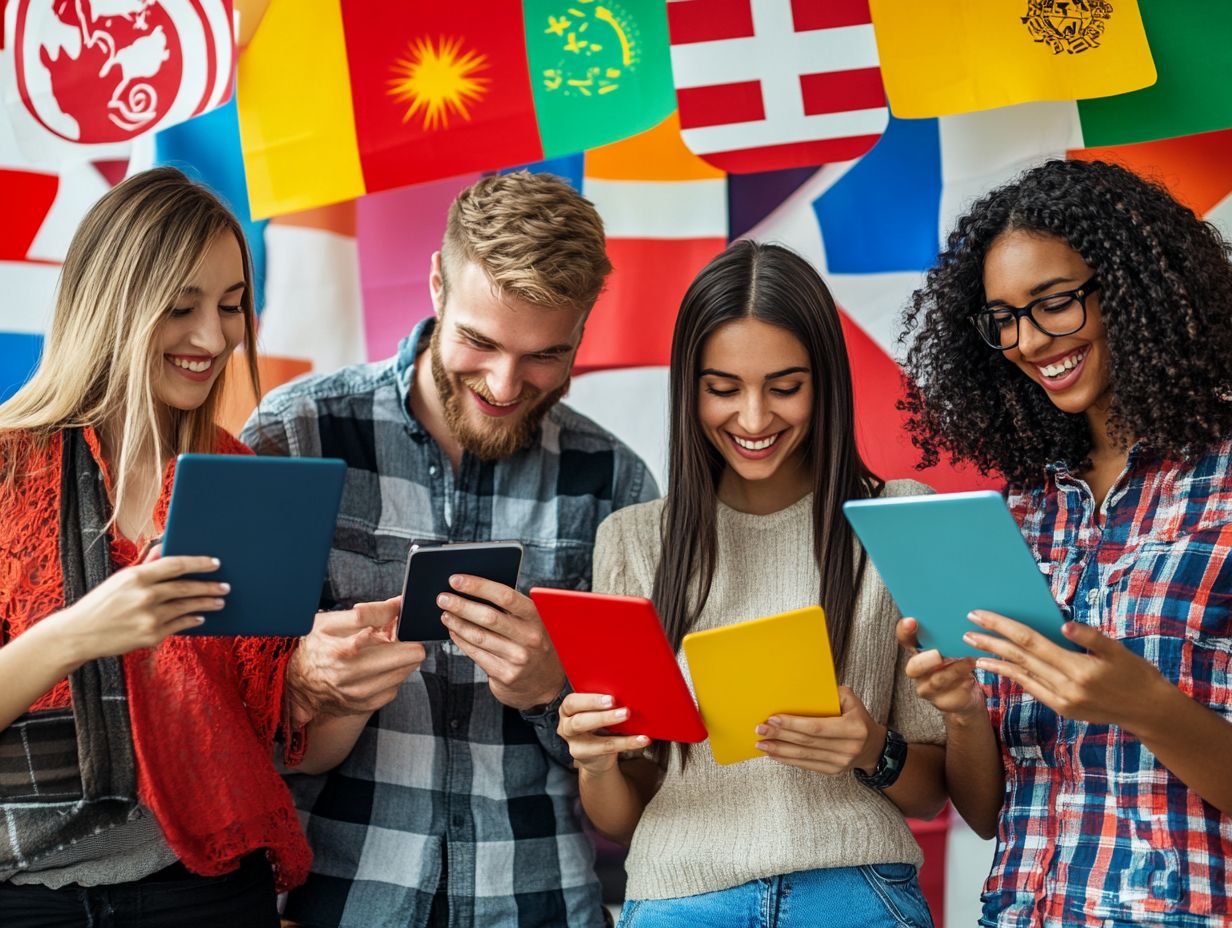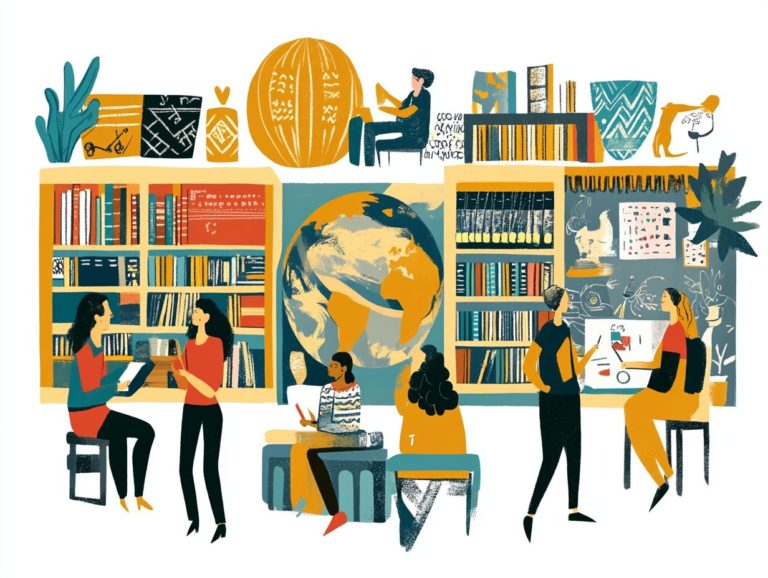7 cultural insights from language learning apps
In today s increasingly interconnected world, language learning apps have become immensely popular! They provide a seamless way to bridge communication gaps and enhance cultural understanding.
This article delves into seven key insights about how these apps facilitate language acquisition and deepen your appreciation for diverse cultures.
From regional preferences in language learning to the significance of idioms and the role of games, each section reveals how technology nurtures cultural connections and supports endangered languages.
Join us as we discover the incredible power of language learning apps!
Contents
- 1. Language Learning Apps Are Popular Worldwide
- 2. The Most Popular Languages to Learn Vary by Region
- 4. Language Learning Apps Can Help Break Down Cultural Barriers
- 5. Different Learning Styles Are Accommodated Through Language Apps
- 6. Language Learning Apps Can Help Preserve Endangered Languages
- 7. The Use of Gamification in Language Learning Is Growing
- How Do Language Learning Apps Promote Cultural Understanding?
- What Are the Benefits of Learning a Language Through an App?
- How Do Language Learning Apps Adapt to Different Cultures?
- What Are the Challenges of Using Language Learning Apps in a Global Context?
- How Can Language Learning Apps Be Used to Promote Cultural Diversity?
- How Will Language Learning Apps Change Our Understanding of Cultures?
- Frequently Asked Questions
- What are the cultural insights that can be gained from using language learning apps?
- How can using language learning apps help develop cultural competency?
- What are some examples of cultural norms that can be learned through language learning apps?
- How can language learning apps help in learning cultural expressions?
- Can language learning apps provide immersion in cultural contexts?
- How can using language learning apps contribute to building cultural sensitivity?
- What is the importance of developing cultural awareness through language learning apps?
Key Takeaways:

Language learning apps are becoming popular worldwide, making it easier to learn new languages.
Top languages vary by region, reflecting diverse cultural interests and motivations.
Many apps include cultural references and idioms, helping learners grasp the richness of a language.
1. Language Learning Apps Are Popular Worldwide
Language learning apps have surged in popularity, transforming the way you engage with new languages and cultures. With mobile accessibility and personalized learning paths, your journey to mastering a language has never been more engaging or effective!
The benefit of learning anytime, anywhere allows you to practice during your daily commute or while waiting in line. Tailored exercises and quizzes adjust to your progress, enabling you to focus on specific areas whether that’s vocabulary, grammar, or conversation skills.
Leading applications like Duolingo and Babbel keep you motivated with rewards and challenges. Community features encourage interaction among learners, allowing you to share tips, practice together, and engage in language exchanges.
This enriches your overall experience and fosters a sense of belonging as you embark on your linguistic adventures.
2. The Most Popular Languages to Learn Vary by Region
The most popular languages to learn can vary greatly depending on the region. Spanish and Portuguese lead in Latin America, while Mandarin holds immense importance in China.
In Europe, French and German attract many learners, showcasing the rich tapestry of languages around the globe.
In North America, for instance, Spanish has gained significant traction, fueled by the growing Hispanic population, making it the second most spoken language in the United States.
Economic factors drive this demand; as China rises as a global superpower, the need for Mandarin instruction has skyrocketed, appealing to those eager to navigate international business complexities.
Learning trends reveal that nearly 200 million people worldwide are currently embracing Mandarin, a clear testament to its increasing relevance. In Europe, French is favored not just for its cultural allure; its status as an official language of major international organizations encourages learners like you to pursue proficiency for career advancement.
4. Language Learning Apps Can Help Break Down Cultural Barriers
Language learning apps are exceptional tools that help you break down cultural barriers. They offer immersive experiences through interactive content designed to incorporate real-life scenarios, cultural immersion programs, and features that enhance cross-cultural understanding.
These platforms often present:
- Video dialogues with native speakers
- Virtual reality experiences that allow you to explore different cultures
- Community forums where you can share insights and experiences with others
You gain not only language proficiency but also a deeper understanding of customs, traditions, and communication styles. By encouraging interactions with diverse cultures, these apps enable you to engage in meaningful conversations, clear misunderstandings, and foster empathy. This ultimately enhances your global communication skills and enriches your personal connections.
5. Different Learning Styles Are Accommodated Through Language Apps
Language learning apps cater to individual learning styles using smart technology. They include engaging content like videos and audio, which enhance your learning experience.
These platforms understand that people learn in different ways. Some prefer visual aids, while others learn better through listening.
Gamification helps you actively participate, making learning an enjoyable adventure. You re no longer just receiving knowledge; you re engaging with it!
Adaptive algorithms monitor your progress and adjust challenges to keep you motivated. This personalized approach, along with quizzes and real-time feedback, supports your unique learning journey.
6. Language Learning Apps Can Help Preserve Endangered Languages

Language learning apps help preserve endangered languages by offering targeted programs that connect you with culture and valuable resources.
These apps don’t just improve your language skills; they connect you to your heritage. For example, Duolingo features options for lesser-known languages, sparking interest in learning them.
The Living Tongues Institute promotes endangered languages through community projects, allowing native speakers to share their stories and traditions online.
Cultural immersion programs enrich your experience by letting you interact with native speakers. This deepens your understanding of the language and its nuances.
This diverse approach is vital for keeping languages alive in our globalized world.
7. The Use of Gamification in Language Learning Is Growing
Gamification in language learning apps boosts your motivation. It encourages daily practice and helps you track your progress, making you feel accomplished.
These interactive elements turn vocabulary learning into an enjoyable journey. Earn points or badges for completing lessons and reaching milestones.
Popular apps like Duolingo excel in these features. They track your progress and provide challenges to inspire you to improve.
This engaging approach not only aids retention but also creates a supportive community among learners. You can share tips and celebrate successes together!
In the end, this makes your language-learning experience rewarding and fun.
How Do Language Learning Apps Promote Cultural Understanding?
Language learning apps enhance your journey by promoting cultural understanding. They give you mobile access to a variety of cultures.
These platforms encourage social learning by connecting learners from different backgrounds. Engage in discussion forums and language exchange programs to share experiences.
By connecting you with native speakers for real-time conversations, these apps break down geographical barriers. This fosters genuine intercultural dialogue.
Multimedia resources like videos and podcasts enrich your learning experience. They allow you to explore different cultures.
As you navigate these interactive spaces, you ll refine your language skills and gain a deeper appreciation for the traditions that define communities worldwide.
What Are the Benefits of Learning a Language Through an App?
Learning a language through an app presents a wealth of advantages, including unparalleled flexibility, personalized learning experiences, and the ability to track your progress effectively. All of these factors significantly enhance your motivation and engagement.
You ll discover that studying becomes a breeze, as you can easily fit lessons into your busy schedule. This adaptability allows you to practice during commutes or breaks, seamlessly integrating language acquisition into your daily routine.
Many of these applications harness adaptive learning technologies that customize lessons to align with your unique strengths and weaknesses, thereby creating a more effective educational journey.
Research indicates that learners who consistently engage with these apps report higher satisfaction rates, reveling in the sense of accomplishment that comes from observing their progress through visual metrics and checkpoints.
One user even remarked how the gamified elements of these platforms kept her motivated, showcasing that language learning can indeed be both enjoyable and efficient.
How Do Language Learning Apps Adapt to Different Cultures?
Language learning apps have a remarkable ability to adapt to different cultures by weaving in cultural insights and employing adaptive learning algorithms that tailor content specifically to your unique needs and preferences.
These innovative platforms analyze your interactions and learning styles, refining lessons that truly resonate with you and your community.
For example, if you re interested in Japanese, you might find yourself encountering vocabulary related to traditional festivals or everyday life in Japan. This way, you re not just picking up language skills; you’re gaining a deeper understanding of local customs and etiquette.
This immersive approach allows you to develop a more holistic grasp of the language, bridging the gap between mere word acquisition and real-world communication.
By emphasizing cultural relevance, these platforms enhance your engagement and retention, transforming language learning into a truly enriching experience.
What Are the Challenges of Using Language Learning Apps in a Global Context?

Navigating the landscape of language learning apps in a global context presents several challenges that you must address. These include overcoming cultural barriers, ensuring that the content resonates with diverse audiences, and tackling the varying levels of technological access that exist across different regions.
Such obstacles not only impede your effective acquisition of language skills but also impact user engagement and retention rates. For example, a lesson crafted for Western learners might include idiomatic expressions that are foreign or irrelevant to users in Asia or Africa. Additionally, the technological disparities mean that while some users enjoy the luxury of high-speed internet and cutting-edge devices, others are left grappling with slower connections and outdated technology.
To rise above these challenges, consider advocating for culturally sensitive content that honors local customs and traditions.
By optimizing apps for lower bandwidths and incorporating offline functionalities, you can significantly broaden your reach to users in less developed regions, ultimately enhancing their learning experience.
How Can Language Learning Apps Be Used to Promote Cultural Diversity?
Language learning apps have the remarkable ability to promote cultural diversity by offering content that celebrates various cultures. They create community social learning experiences that connect you with users from different backgrounds, encouraging a deeper cross-cultural understanding.
These platforms curate lessons that bring traditional stories, music, and cuisine from different cultures to the forefront, enriching your learning experience in a truly varied way.
Many apps include community forums and discussion groups where you can engage with native speakers and share your own cultural experiences, making the process interactive and enjoyable.
Features like language exchange buddy systems allow you to practice with others, fostering friendships that transcend geographical borders.
By integrating cultural insights and encouraging meaningful dialogue, these applications not only teach you languages but also help build bridges between communities, enhancing your global awareness and appreciation for diversity.
How Will Language Learning Apps Change Our Understanding of Cultures?
The future implications of language learning apps on cultural understanding are important for everyone. These apps can transform how you communicate globally, foster greater empathy, and promote cultural exchange like never before.
As technology continues to advance, features like augmented reality and real-time translation could become essential parts of these platforms. This evolution means that you won’t just be learning new languages; you’ll also have the opportunity to immerse yourself in different cultural contexts. This makes your interactions more meaningful.
Imagine the possibilities! You can connect with people worldwide and truly understand their cultures while visually experiencing their traditions through immersive apps. This will deepen your personal connections.
In this dynamic environment, you can cultivate a nuanced appreciation for various customs and perspectives, ultimately bridging gaps that once seemed insurmountable. With the right tools at your fingertips, navigating cultural landscapes will become easier and more enriching.
Frequently Asked Questions
What are the cultural insights that can be gained from using language learning apps?
- Cultural competency: understanding and respecting cultural differences.
- Understanding cultural norms.
- Learning cultural expressions and immersion in cultural contexts.
- Building cultural sensitivity.
- Developing cultural awareness.
- Fostering cross-cultural communication skills.
How can using language learning apps help develop cultural competency?

Language learning apps often offer cultural lessons alongside language lessons, providing users with knowledge about the history, customs, and traditions of the culture associated with the language. This exposure can help develop cultural competency by increasing understanding and respect for different cultures.
What are some examples of cultural norms that can be learned through language learning apps?
Examples of cultural norms that can be learned include greetings, etiquette, communication styles, and social customs. Understanding these important aspects of a culture can help avoid misunderstandings and promote cultural sensitivity.
How can language learning apps help in learning cultural expressions?
Language learning apps include lessons and activities focused on common cultural expressions and idiomatic phrases used in everyday conversations. This not only helps in understanding the language better but also the culture and its unique ways of expression.
Can language learning apps provide immersion in cultural contexts?
Yes, many language learning apps offer features such as virtual reality or interactive videos that simulate real-life situations in the target culture. This allows users to immerse themselves in the culture and practice their language skills in a more authentic and meaningful way.
How can using language learning apps contribute to building cultural sensitivity?
By providing cultural lessons and exposure to different perspectives, language learning apps can help develop cultural sensitivity. This means being aware and respectful of cultural differences and being able to communicate effectively with people from different cultures.
What is the importance of developing cultural awareness through language learning apps?
Developing cultural awareness can foster mutual understanding and respect between people from different backgrounds. It promotes global citizenship and opens up opportunities for intercultural communication and experiences.
Start exploring these apps today and open new doors to cultural understanding!





